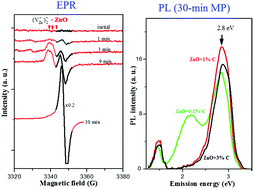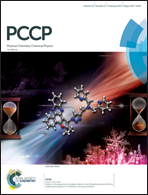Formation of carbon nanodots with different spin states in mechanically processed mixtures of ZnO with carbon nanoparticles: an electron paramagnetic resonance study†
Abstract
Mixtures of zinc oxide with carbon nanoparticles, ZnO + xC (x = 0.1%, 1% and 3% by weight), were subjected to mechanical processing (MP) in a hermetically sealed grinding chamber. Using electron paramagnetic resonance (EPR) spectroscopy, we monitored the evolution of spin centers in CNPs. While the initial CNPs were EPR silent, their short-duration MP (tMP) gave rise to emergence of low-intensity carbon signal. Increasing the sample temperature at tMP > 9 min induced CNP oxidation, which lead to a dramatic increase in the intensity of C signal. The oxidation process also manifested itself in the appearance of a photoluminescence (PL) band at ∼2.8 eV, which is characteristic for carbon nanodots with an average size of ∼2.7 nm. A limited amount of oxygen in the grinding chamber lead to different ways of carbon nanodot oxidation, depending on carbon content in the samples, which in turn influenced the characteristics of C EPR signals observed. The number of spins calculated per one CNP (NSOP) was found to depend on carbon content in ZnO + xC samples. Based on a detailed analysis of EPR spectral lines, we suggest the existence of a broad variety of relaxation mechanisms for forming C paramagnetic centers.



 Please wait while we load your content...
Please wait while we load your content...